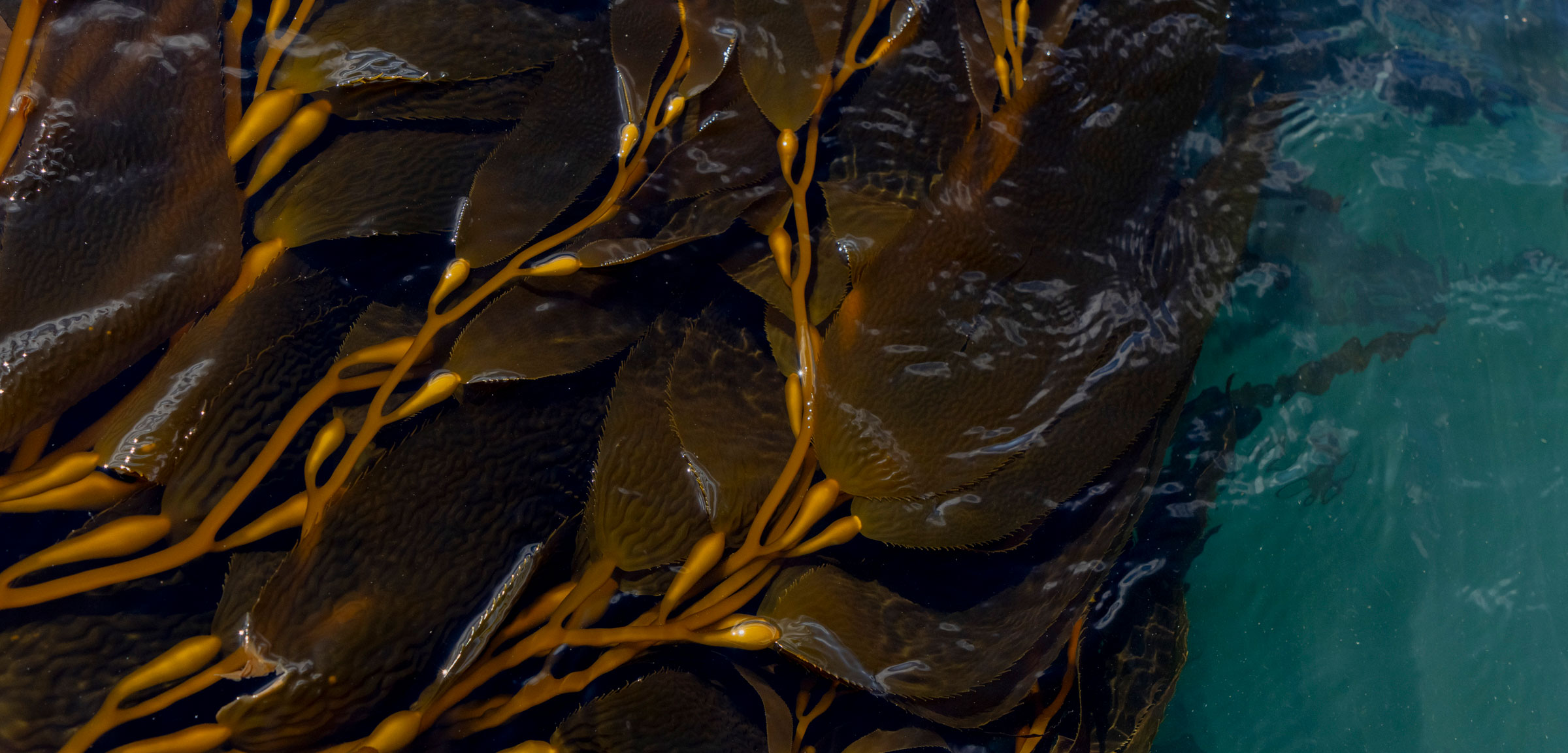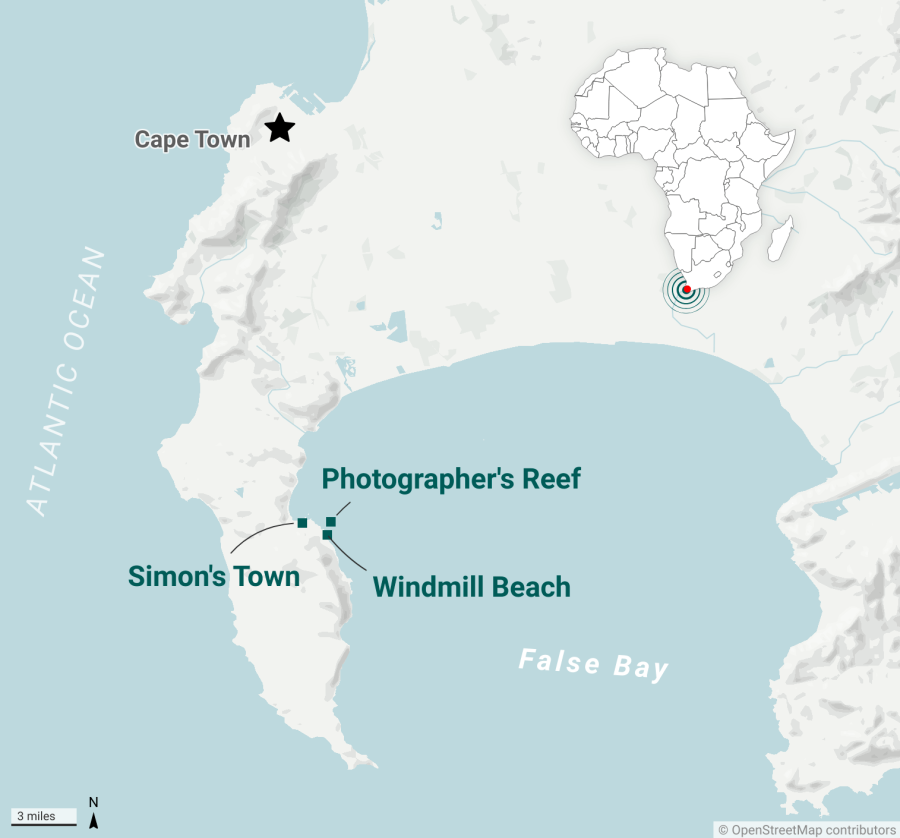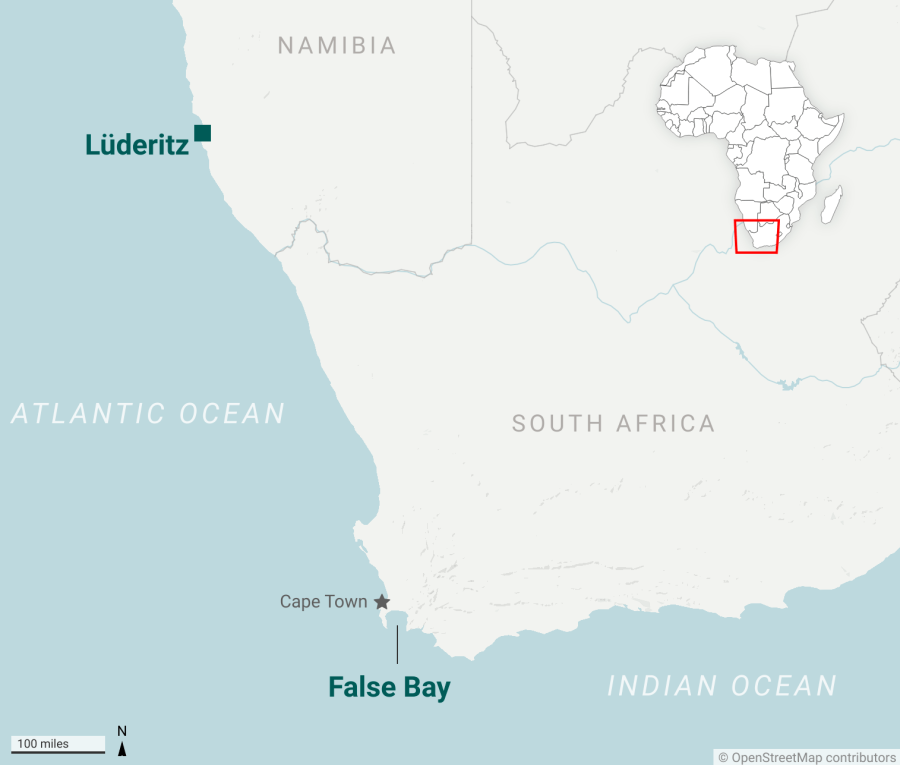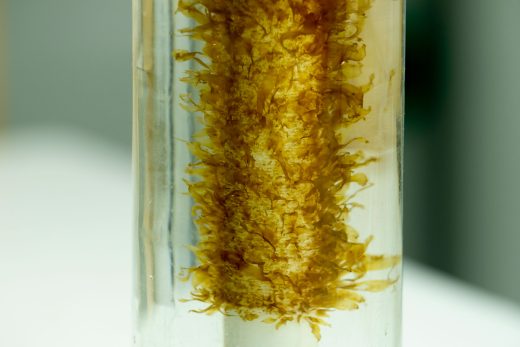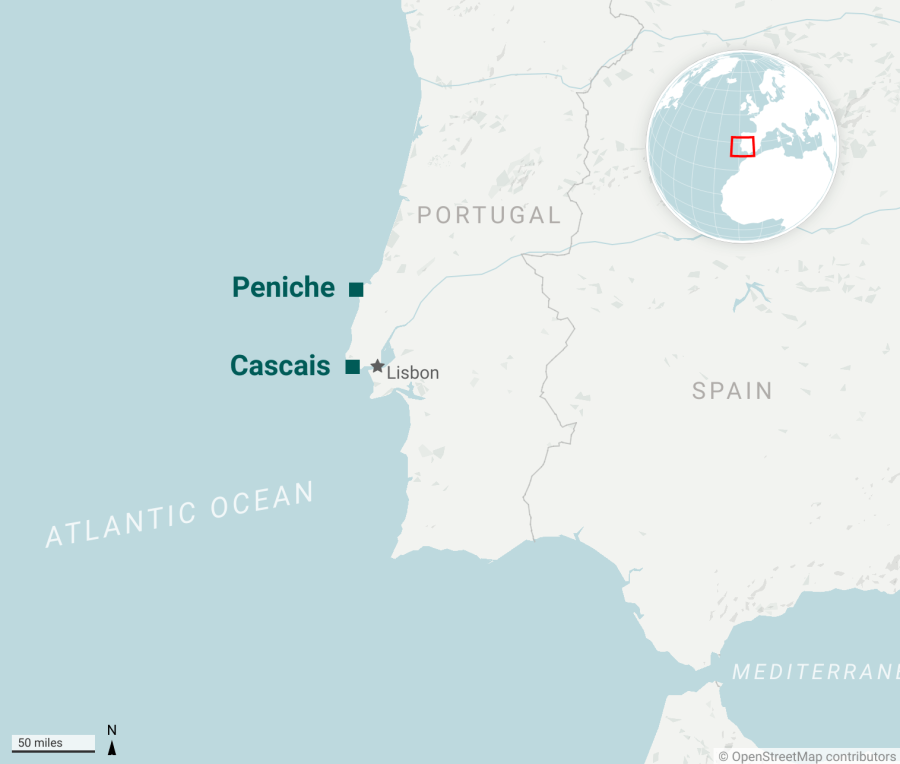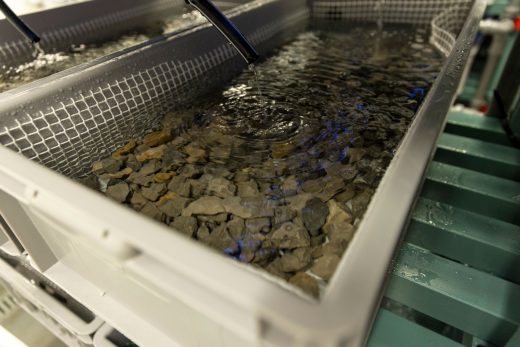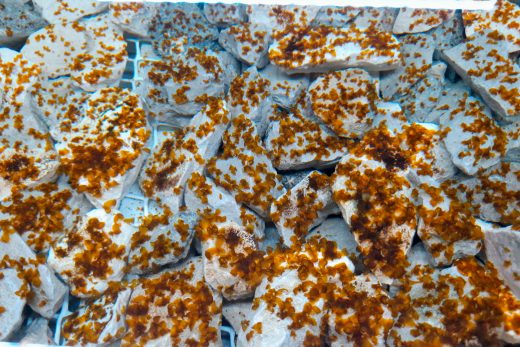Exploring the Forests of the Sea
Under ocean waves, kelp functions much like a forest ecosystem on land. What are we doing to protect it?
Article body copy
This story was originally published by the Bulletin of the Atomic Scientists and is reproduced here as part of the Climate Desk collaboration.
When Maggie Reddy was growing up on the eastern coast of South Africa in the 1990s, the tiny oceanside town where her family lived offered just two recreational options for children: the library and the beach. Though Reddy had been born categorized as Asian because of her distant Indian heritage, the government policy of racial separation was abandoned when Nelson Mandela and the African National Congress party took over when Reddy was six. The two resources straddling the coastal road that ran through town became, for the first time, open to her. She lapped them up. “I was always reading, with massive boxes of books everywhere,” she says. “And I was totally fascinated by this marine environment.”
Other kids delighted in the big, cute marine creatures that inhabit South Africa’s 2,800 kilometers of coastline—octopuses, penguins, seals, dolphins, whales—but Reddy was drawn to the slimy brown and green stuff nobody wanted to touch, and that most people regarded as blocking their view of the fish: seaweed. At 18, she enrolled at South Africa’s University of KwaZulu-Natal, the college closest to home, but soon transferred to the University of Cape Town, on the country’s west coast, because it was one of the few places where phycology—the study of algae—was taken seriously. “I kind of liked the idea of studying something nobody really knew anything about,” she says.
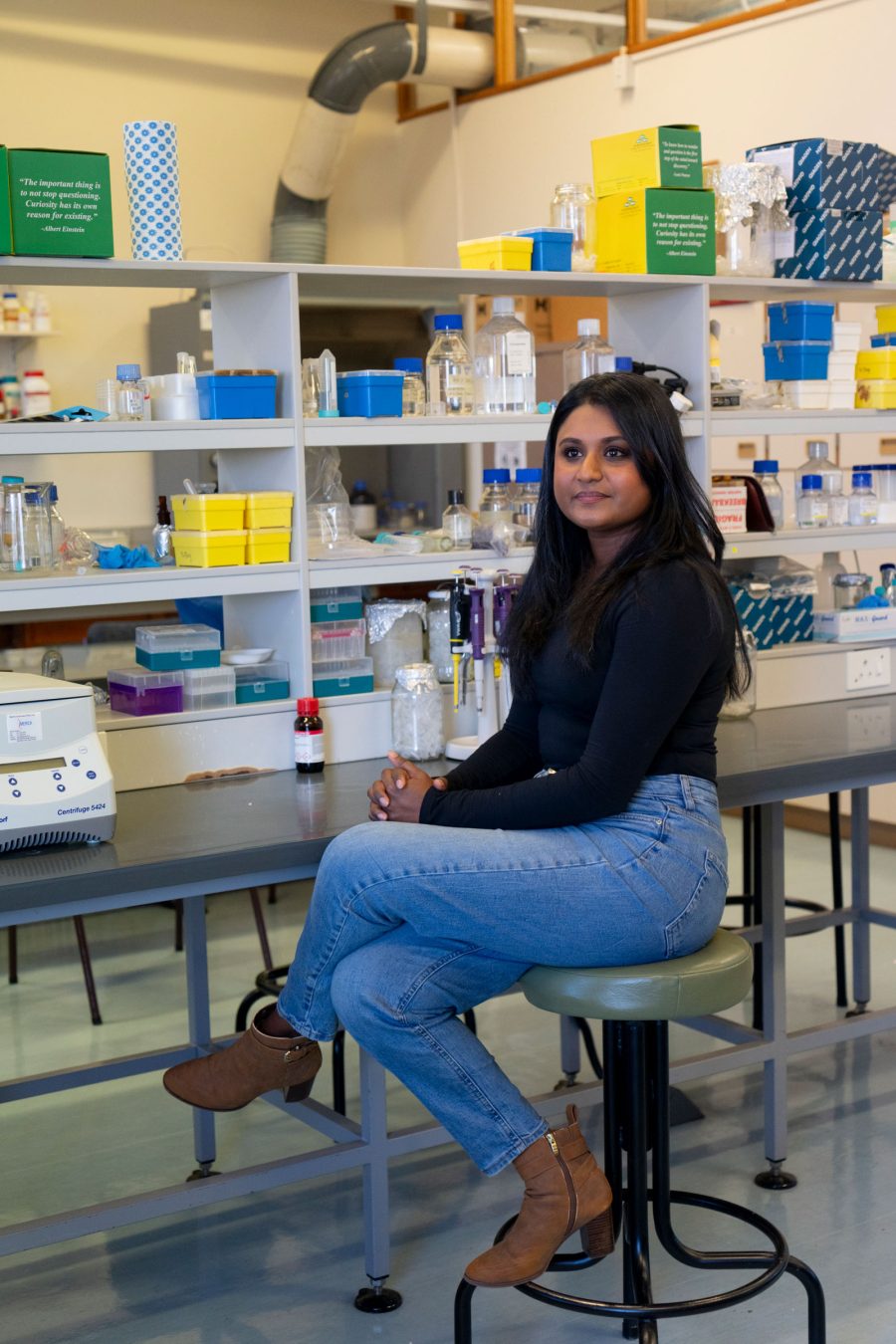
Maggie Reddy, in her lab at the University of Cape Town in South Africa, researches kelp. Photo by Adriane Ohanesian
When I visited Reddy in August, she had planned to spend the day in the field—which is to say, on a boat—but the wind wasn’t cooperating. So we sat in the wood-paneled office she took over from her former advisor at the University of Cape Town, where Reddy is now a lecturer in the department of biological sciences. Pressings of dried seaweed, preserved just like flowers in a book, were stored beside her. (Even today, Reddy’s family hates going to the beach with her because she can’t resist the urge to collect such samples instead of relaxing like a normal person.)
As her marine studies continued, Reddy came to understand that without kelp—an umbrella term for a variety of large, fast-growing marine plants, usually brown or army-green in color, which can also be categorized as a type of seaweed—little of the “charismatic” ocean life in and around it would be possible. Shysharks, ragged-tooth sharks, some species of ray, and other fish lay their eggs among the kelp off Cape Town, and it provides habitat where juvenile and small fish can hide from predators. In other places, it might be different species of kelp and different marine animals, but the seaweed performs the same general habitat-providing role.
The South African marine ecosystem has been significantly understudied compared to offshore life in Europe and North America; science being largely a not-for-profit endeavor, field research tends to occur in places that are easily accessible and near the back doors of major universities, which are more plentiful in the Global North. And kelp forests and seaweeds are significantly understudied compared to other marine ecosystems. Even such obscure topics as salt marshes, seagrasses, and mangroves have seen upward of 10 times as many scientific papers on restoration efforts as kelp has. In the category of Earth’s natural features with the most name recognition, Australia’s Great Barrier Reef probably ranks up there with the Amazon and the Grand Canyon. Still, the Australian Research Council provides less than 10 percent of the funding it has devoted to coral reef research for its kelp forests, even though kelp forests stretch along the continent’s entire southern coast.

False Bay near Cape Town, South Africa, is one of the few places on Earth where kelp forests are expanding. Photo by Adriane Ohanesian
Such neglect is starting to change—not only in South Africa and Australia but globally—thanks in part to people like Reddy. “Now, it’s been this huge burst,” Reddy says. “Everyone’s getting to know what a kelp forest is.”
Kelp forests cover six to seven million square kilometers of ocean—an area greater than the Amazon rainforest. While the Amazon is branded as “the lungs of the Earth” for its extensive oxygen production, it’s actually marine algae, including kelp, that have been responsible for the preponderance of oxygen in the atmosphere. Kelp forests’ role as biodiversity hotspots, which they also share with the Amazon and other jungles worldwide, make them basically the coral reefs of cold water, except that kelp is even more extensive: kelp is found in more than the 25 percent of coastal areas that harbor corals, covering five times as much ocean area. Reddy suspects that extensive kelp forests proliferate far offshore, too—entire forests we don’t even know about yet. Though we might be familiar with the kelp whose fronds (or “blades”) we can see from the beach floating on the surface, there are species that don’t reach that far up. And there are forests in the distant reaches of vast oceans, providing their ecosystem services out of sight and out of mind. One of these was discovered only in 2018, off southern Mozambique, and hadn’t been predicted in computer models programed to suggest where to look for kelp. “I actually believe there are these deepwater populations all over,” Reddy says. One of her research projects leverages her postdoctoral experience in genomics to find traces of previously undiscovered kelp through environmental DNA.
Copious offshore kelp would be good to know about because of its importance to other life, local and global. Fossil evidence indicates a history of kelp forests going back 32 million years, suggesting they played a role in the evolution of many foundational marine animals. “Kelp forests provide critical ecosystem services to humans, similar to those provided by coral reefs and tropical forests,” Thomas Wernberg, a Norwegian marine biologist at the University of Western Australia, and his coauthors wrote in Science in 2021. An average of $500-billion of services, according to a 2023 estimate, accounting for $6.5-billion in economic activity in Australia alone. Fish and other aquatic foods that are born in or later become inhabitants of kelp forests account for a significant and growing share of the protein consumed by humans, especially in the developing world (though much of the growth is from aquaculture).
But humanity’s interest in healthy kelp forests involves much more than fishing and tourism (and fishing tourism); Indigenous peoples have a long history of using kelp in a variety of ways. “It’s used for medicine, woven materials, pigments …” says Loretta Roberson, associate scientist at the University of Chicago’s Marine Biological Laboratory in Massachusetts. A visit to any garden store will testify to the biostimulant effect of kelp on terrestrial plants, a use that could become key to its expansion as a replacement for the carbon-intensive ammonia-based fertilizers used by major agricultural companies that are coming under social, political (and, perhaps someday, economic) pressure to reduce their greenhouse gas emissions. Kelp is also a potential feedstock for sustainable products ranging from packaging material to footwear.
Also, of course, you can eat it. (And you already have, if you’ve ever had a sushi roll.) With an exceptional nutritional profile, kelp has recently become an ingredient trend among celebrity chefs and devotees of Martha Stewart, and scientists recently estimated that seaweeds could keep 1.2 billion humans alive in a nuclear winter.
Of course, post-zombie-apocalypse humans aren’t the only ones who can benefit from kelp, as Reddy discovered as a child. Examples abound, but the tops for cuteness are sea otters wrapping themselves in it before going to sleep so they don’t drift away and the humpback whales that like to form kelp into hats. (Play? Muscle training? Skincare routine? No one really knows why.)
Sea otters wrap themselves in kelp so they don’t float away while sleeping and—as this video shows—use it to clean themselves. Video by NOAA/Biodynamics, Inc.
And marine mammals aren’t the only aquatic animals that find kelp useful. Plants sampled in Norway were found to support, on average, 8,000 individuals from around 40 large invertebrate species, including economically significant ones such as lobster; more than 1,800 flora and fauna species were recorded among kelp just in the waters of the United Kingdom. Even dead kelp plays a role. The repellent little insects buzzing around seaweed washed ashore on beaches worldwide are feeding on it; they in turn become food for the crabs making their homes underneath. Oystercatchers lay their eggs in decaying kelp, as do snowy plovers and other birds.
Just as the Amazon rainforest provides oxygen as it absorbs carbon from the atmosphere, kelp plays a role in carbon sequestration—one that is only starting to become well described. Current estimates place the amount at around 173 million tonnes annually (and perhaps as high as 268 million tonnes) or about equivalent to the carbon contained in the annual emissions of five percent of the world’s automobiles. Much of the sequestered carbon is released when the kelp dies, but new growth can replace that, and some of the dead kelp falls to the ocean floor, where it’s sequestered long-term. How much exactly is an area of developing research, but the kelp forests along Australia’s southern coast alone provide three percent of the sequestered carbon in the world’s oceans (i.e. blue carbon), according to a 2020 paper by the University of Western Australia’s Karen Filbee-Dexter and Wernberg (with the total blue carbon amounting to some three percent of annual global greenhouse gas emissions).
Kelp is under severe threat along several vectors. Documented areas of degraded kelp forests total 15,000 square kilometers—and those are just the places science knows about. Over the last 50 years or so, kelp forests in decline have come to outnumber those that are growing and also those in stasis. Kelp killers range from coastal development—as sediment accumulating on the seafloor covers the rocks or other hard surfaces the plants need to fix to—to changes in the ecosystem. Sea stars along the California coast consume sea urchin, which dine on the lower portions of kelp that affix the plants to the seafloor. But a mysterious wasting disease struck sea stars beginning in 2013, and in the absence of such predators, Roberson says, “Sea urchins go berserk, and they mow off the kelp. Anything new that starts to grow, they eat.” Toxic effluents such as the discharge of raw or under-treated sewage don’t help the kelp outlook, either.

A diver surveys sea urchins in the remnants of a former kelp bed located off the southern Oregon coast. Photo by Scott Groth
The most widespread, severe, and intractable threat to kelp forests is carbon dioxide. California suffered a double whammy after sea stars started to decline when a record marine heat wave linked to climate change struck the region in 2014. Increasing acidification as the ocean absorbs carbon can affect kelp growth, and, in a sad irony, kelp can actually reduce the acidification that goes along with the ocean warming from carbon emissions. Particularly in Australia, the extreme heat that has caused devastating wildfires and coral bleaching has also severely damaged the continent’s kelp. The plants do best in temperatures below 20 °C, which occurs in ever-narrowing bands below about latitude 30° south and above about 45° north in most places. The warming creates a feedback loop, as diminishing kelp reduces the amount of carbon it stores, which leads to more warming, which further diminishes kelp. Increased temperatures seem to degrade the resilience of kelp to other stressors, but when other factors are going well, it can better tolerate the heat, says Aaron Eger, a postdoctoral researcher at the University of New South Wales in Australia and program director of the Kelp Forest Alliance, a nonprofit based in Sydney, Australia. “You can’t just put a marine protected area in and expect it to increase kelp’s thermal tolerance,” he says, “but it’s still a piece of the puzzle. There is increased resilience of kelp forests to heat waves if it’s in a healthier state.” Researchers from the Scripps Institution of Oceanography at the University of California San Diego are finding the same thing with regard to coral reefs. And like coral reefs, nearshore kelp forests protect coasts from the ravages of the severe storms that are increasing with climate change.
Jannes Landschoff is a marine biologist and a project leader at Sea Change Project in South Africa, which has dubbed the country’s kelp beds the Great African Sea Forest (one of two such efforts in the southern hemisphere to rebrand kelp forests as deserving of attention and protection; the other calls Australia’s kelp forests the Great Southern Reef). His deep-set eyes seem to radiate intensity, or maybe it’s just the seriousness of what he’s saying: “It’s difficult to get kelp back once it’s gone, because ecosystems get replaced by other things. Once a stable state is lost, it’s difficult to get back to that level of integrity and complexity.”
On a crystal clear morning in August, I met Landschoff beside a small cove near South Africa’s Simon’s Town, which, with its artisanal bakeries, impressive ocean views, and Victorian architecture, is basically the Sausalito of Cape Town, except with penguins and baboons. It edges on False Bay, an expansive horseshoe-shaped body of water bounded by 33 kilometers of shoreline on each side, meaning that it’s about the size of Los Angeles, California. (“False” because early European seafarers confused it with nearby bays.) Behind Simon’s Town rises Table Mountain, Cape Town’s iconic topographical feature, and across the bay irregular mountain peaks rise to 1,250 meters barely three kilometers from the coast.
As part of the vague borderline between the Indian and Atlantic Oceans, False Bay is subject to two major currents, one from the west that’s cold and rich in nutrients, the other, warmer one from the Indian Ocean side. “These two currents meeting create favorable conditions for an incredible mixture of biodiversity,” says Loyiso Dunga, whose thesis as a graduate student at the University of Cape Town included the first map of South Africa’s kelp forests via satellite imagery. Indeed, the species diversity of those forests is unique in the world. In summer, trade winds from the southeast create huge upwellings, bringing cool water from the depths toward the surface, which helps the kelp forest grow. As recently as a few decades ago, these winds occurred only on the western shores of South Africa, from Cape Town up to Namibia, but—presumably due to climate change—the annual meteorological event has recently turned the corner eastward, into False Bay and the marine protected area there. “There the kelp is able to establish without the pressures of harvesting and fishing,” Dunga says. As a result, False Bay is one of the few places in the world where kelp is increasing.
Those circumstances seemed to make False Bay a good place to examine a healthy kelp forest (“relatively” healthy, Dunga is quick to point out, having assessed the threat status of all South Africa’s kelp forests), hence my appointment with Landschoff. He was the scientific advisor for the film My Octopus Teacher, which won the 2021 Academy Award for best documentary; he chose for our dive the cove where the film was shot. (I agreed not to reveal which cove, lest it be ruined by busloads of tourists and their sunscreen and sandwich wrappers.)

Marine biologist Jannes Landschoff prepares to dive into the kelp forest where the film My Octopus Teacher, on which he served as scientific advisor, was filmed. Photo by Adriane Ohanesian
Steps and water slides descend into parts of the cove behind a jetty, for recreational swimming, but it was off-season when I visited, and not even the baboons would join us in the water in this weather: 14 °C in the water, 17 °C onshore. Either because he is insane (what I think) or because he can better track marine life if he’s more connected to his surroundings (what he says), Landschoff prefers snorkeling without a wetsuit—just a hood and mask. But photographer Adriane Ohanesian and I suited up. Landschoff pointed out the seaweed type that’s used for sushi, growing on rocks in a tidepool, and drew my attention to a warty pleurobranch. “It’s a very cool creature that walks around and tries to eat other slugs,” he told me (“walks” being a rather generous description of its method of locomotion). “Such a cool animal,” he said, chuckling. It waddled along the seafloor, just several centimeters below the surface, past sea urchins that had cleverly covered themselves in pieces of kelp.
A warty pleurobranch moves past sea urchins that have covered themselves in pieces of kelp for sun protection in False Bay. Video by Paul Tullis
They use the kelp as sunscreen, deploying their photosensitive tube feet, which extend between and beyond their notorious spines, to grab onto detritus as it floats by, or they can actually walk on the tube feet until they find a piece. (Yes, sea urchins can move; you just have to slow down to their speed to perceive the movement.)
Landschoff and colleagues discovered two new species of shrimp while filming My Octopus Teacher. “We’re always finding new species,” he said. “We’re very lucky to have a coast like this, with clean water; it’s really a miracle considering how close it is to Cape Town. So we’re trying to explain to funders, the media, and government what a treasure trove this is.” The idea of naming the kelp off South Africa and Namibia the Great African Sea Forest came out of the intensive diving during filming—Landschoff and producer Craig Foster were in the water here nearly every day for seven years—and the realization that the area needed an identity to be conserved. (They borrowed the idea from Wernberg, the Norwegian who had named Australia’s kelp forests the Great Southern Reef.)
“We don’t know where kelp forests grow, we don’t know which species are where and how abundant they are, we don’t know how many different species there are—the absolute basic biodiversity data, we just don’t have,” Landschoff said. Around 45,000 species inhabiting kelp off Europe have been described, while in South Africa it’s less than a third of that. Even though, suspects Landschoff, South Africa’s kelp forest is even more diverse. “Looking at the size and ecology, you’d think it’d have at least as many species, but we really don’t know,” he said. This reflects a larger problem with kelp: “kelp forest” isn’t even defined as an ecosystem, the way “savanna” and “rainforest” are. Reddy estimates that only a quarter of the diversity of seaweed species around South Africa has been taxonomically categorized.
The 1001 Seaforest Species project that Landschoff leads for Sea Change Project is attempting to fill this gap in knowledge in South Africa, and he and colleagues at South Africa’s Stellenbosch University have found 50 species of amphipods (shrimplike crustaceans) living in the holdfast of just one kelp plant. (Holdfasts are comparable to a plant’s roots; they are the part by which kelp fixes itself in space, except that holdfasts are uncovered and kelp absorbs nutrients from water around the entire plant. They look somewhat like the roots of the banyan tree.) Half of these species were not described in the scientific literature, Landschoff said: “It’s absolutely crazy.”
To my chagrin and shivers, it was now time to get in the water. I walked awkwardly in my fins, careful not to step on some organism before it could be discovered by science, until I was far enough out that the water was deep enough for swimming. Resisting my usual tendency to scream-groan when getting into cold water—wetsuits take a few minutes before the water in which they encase the wearer is warmed up by their body heat—I dunked myself and took a look around.
The purpose of this expedition was for Landschoff to show me various aspects of the kelp environment, but he wasn’t even necessary: life teemed beside, below, and above me. A bluish-greyish-purplish fish snuggled up against a frond. And I saw sea stars; a substance resembling cement that’s actually a living being called encrusting coralline alga; nudibranchs—another type of sea slug like the pleurobranch—and goat’s eye limpets, a type of sea snail that grows its shell to fit the rock it chooses as a home. If a predator tries to get under the shell, the snail can slam the shell down on it like a guillotine, sometimes lethally.
Amid the distant surf, lapping waves, and wind, sounds at the surface were indistinct, but I suddenly became aware of Landschoff calling me. He had found an octopus. I swam over and followed his pointing finger to the floor, at that location about a meter below the surface, where I saw a suckered arm extending from beneath a large rock wedged into the sand, forming a sort of cave where the animal had made its home. Octopuses (octopi, Ed Yong informs us, would be correct if the word were Latin, but it’s Greek so it should really be octopodes; in English, octopuses shall suffice) have remarkable camouflaging capabilities. They change not only color but texture in an instant, so the body of this one wasn’t immediately evident. But a closer look revealed more tentacles, a head, and an eye. Landschoff placed his camera outside the den to make a video, and the animal, to my utter astonishment, reached its arm out, grabbed the device, and pulled it back into its den. Landschoff had to intervene to wrest it back.
A curious octopus inspects a camera in False Bay. Video by Jannes Landschoff
Laughing through my submerged snorkel, I started to choke. I rose to the surface and, losing all journalistic objectivity, managed to exclaim, “THAT WAS THE COOLEST THING I HAVE EVER SEEN.” (I have seen lemurs leaping in Madagascar; starlings swarming in Botswana, blue-footed boobies dancing in the Galapagos Islands; and cheetahs hunting in Kenya, and this statement was not hyperbole.)
“They’re very curious creatures,” Landschoff said, exhibiting far greater calm than I. “I’ve seen them do that before; usually they inspect it with their arms for a few minutes, then toss it back out.”
Back onshore, I asked if the octopus we’d seen might be a relative of the one in the film. Landschoff said it was possible. “You can tell an individual octopus the way you tell apart the puppies in a litter of black Labradors,” he averred. “Though that’ll never pass peer review.”
I recalled what Mike Barron, the marine biologist who leads a research and diver development organization in Simon’s Town called Cape RADD, had told me the previous day, when I accompanied a diving survey at a place called Photographer’s Reef. “The kelp are the keystone species, where if they become imbalanced, like [what] happened in California, it could have a cascading effect on the ecosystem,” he said. The biodiversity that the octopus had so dramatically represented—including key species on the food chain such as rock lobster and crayfish—all comes under threat when a kelp forest is degraded or diminished.
“We don’t really know where is the tipping point,” Dunga later tells me. “But we know what can happen—we’ve seen examples globally.”
Ending the use of fossil fuels, reducing runoff of sediment and toxicants from land, and establishing more marine protected areas are all strategies that have been contemplated as means of conserving kelp forests and stemming their further decline. Each of these efforts being a rather tall order, marine biologists, conservation scientists, and environmental groups are increasingly working at the less ambitious but perhaps more feasible task of restoring kelp forests. Wernberg says such programs “are orders of magnitude behind other ecological restoration efforts in terms of what we need to do to keep up with the current rate of loss”—about two percent a year, or twice as fast as coral reefs. Yet of all coastal ecosystems, underwater forests have the smallest amount of restored area. University of New South Wales’s Eger and colleagues put together a comprehensive survey of kelp restoration projects in 2022; more than three-quarters of the hundreds of restoration projects they managed to document were smaller than a single hectare, and just three were greater than 100 hectares.
Restoration for restoration’s sake is, of course, constrained by funding. The United Nations Decade on Ecosystem Restoration—an effort to “prevent, halt, and reverse the degradation of ecosystems worldwide”—lists not a single kelp restoration project; there are 19 involving forests on land. But because of the many uses of kelp, a growing number of companies are cultivating these giant seaweeds. The rapidly replenished tops of fully mature plants—in some areas, kelp can grow 60 centimeters in a day—are harvested to make growth accelerator or drought protectant for terrestrial crops, as well as alternative plastics, ingredients for processed foods, food itself, and (one is obliged to mention) algae-derived biofuels. (Companies have been chasing this holy grail for decades without bringing the cost down to anything close to competitive with traditional transport fuels; one, California’s Solazyme, gave up and started making cosmetics from its algae instead.)
Curious as to whether the profit motive might be the engine that could drive kelp forests back to health, photographer Ohanesian and I piled into a Volkswagen Golf at 4:00 a.m. and headed north from her house overlooking Cape Town’s Hout Bay, driving 11 hours through terrain that brought to mind the US Southwest, into Namibia. There, a company called Kelp Blue, founded in 2020, cultivates kelp from spore to blade to process it into biostimulants (and other products, it hopes). The US-based organization Project Drawdown, which evaluates climate solutions, has quantified drastically expanded seaweed farming as potentially removing 4.7 gigatonnes of CO2 equivalent from the environment before 2050 (more, of course, if the industry is developed further than in their scenario). That’s not a lot in light of total annual emissions of 37 gigatonnes, but it’s more than other ideas that have seen splashy headlines, such as green or cool roofs (one gigatonnes) and expanded high-speed rail (3.6 gigatonnes).
We met cofounder Daniel Hooft in a driveway behind the building Kelp Blue occupies a block from the harbor, three doors down from a Shell fuel station in the port town of Luderitz (population 12,500 as of the most recent census). A jolly coterie of young men and women dressed for a day on the sea (i.e. partially) were loading an ancient Land Cruiser with scuba gear and various other equipment for a dive that we would soon accompany them on.
Hooft, a tall Dutchman with roots also in Canada, spent 20 years with Shell, drilling oil and gas wells and in various management and innovation roles, until he decided he’d rather do something more meaningful with the rest of his life. During this period in the axiological wilderness, his wife attended a lecture by Tim Flannery, who’s sort of Australia’s version of David Attenborough, about the ability of large seaweeds to draw carbon from the atmosphere and boost biodiversity. Telling him about it later, she was laughingly skeptical, but Hooft thought, “Maybe I should read up on this.”
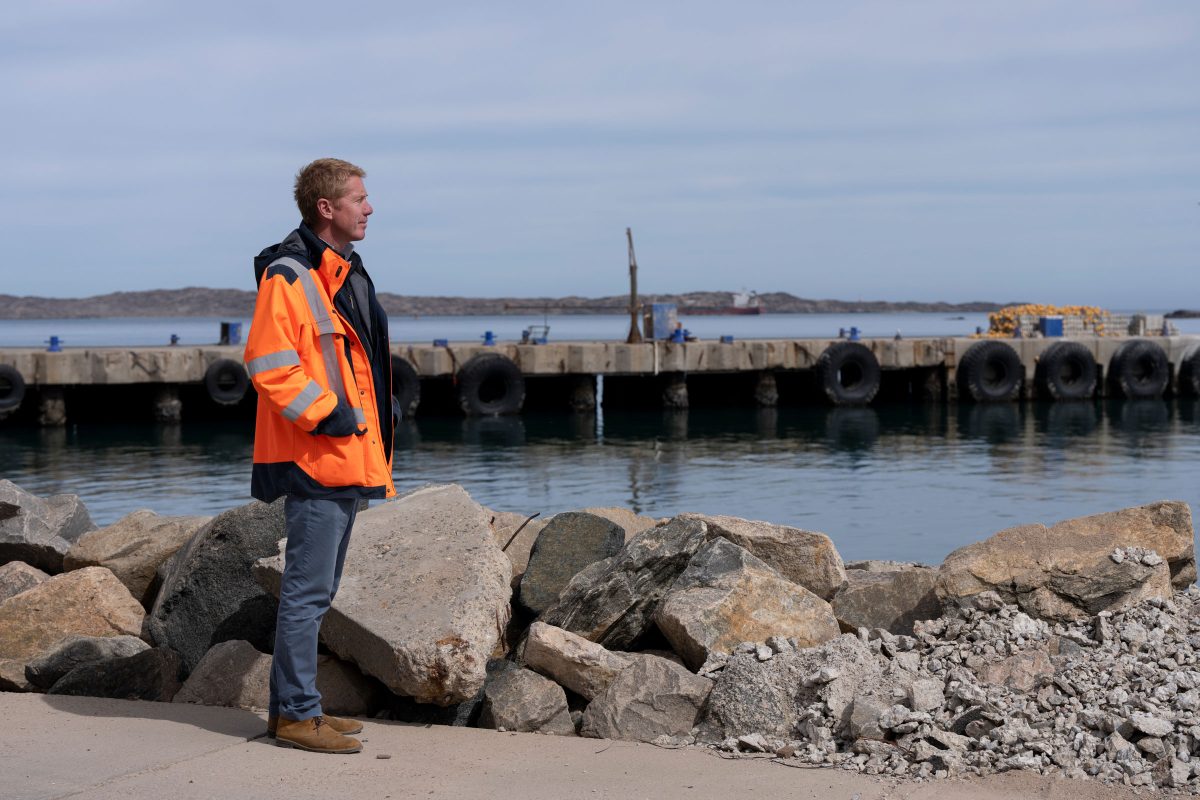
Daniel Hooft, founder and CEO of Kelp Blue, stands outside a former cannery in Luderitz, Namibia, which the company has converted into a processing plant. Photo by Adriane Ohanesian
Seaweed farming, he learned, is hampered by three factors: it is manual, small-scale, and seasonal. Kelp Blue aims to alleviate these problems by growing thousands of hectares, harvesting it mechanically, and finding places on Earth where giant kelp could be grown year-round. An old friend of Hooft’s who used to draw maps for NATO came up with an algorithm to find a place with high nutrients; favorable temperatures, seabed conditions, and regulatory environment; and few logistical constraints. The pin dropped on Namibia. “It was technically an amazing challenge, in an environment I like, and it’d never been done—I had to try it,” Hooft says.
A 29-year-old former student of Reddy’s named Michael Fleischman runs a lab in a refrigerated shipping container in the parking lot for the Kelp Blue building; there, kelp is seeded onto twine. Giant brown kelp is a perennial, so new “stems” (actually called stipes) continually shoot out and up from its holdfast; seed it once, and you’re good for 30 years or so, which keeps costs down. The twines are affixed to nets anchored to the seabed, and the holdfasts affix themselves to the net. In a matter of months, the kelp has grown 15 meters to the surface.
A modern version of a machine the allies developed during the Second World War to harvest wild seaweed to make potash for the munitions industry has enabled a dramatic scale-up from the manual kelp harvesting that’s been practiced for centuries. Kelp Blue patented a bioreactive processing method to bottle the formula the company is now selling.
Kelp has evolved to fight off the sea’s many viruses and diseases, defend itself against enemies, and outcompete other plants by growing rapidly. Hooft’s company is finding in trials on a range of crops in Europe that what works for kelp also works on land. Kelp extract boosts the soil microbiome, accelerating the capture of nitrogen and conversion of the element by soil enzymes into absorbable phosphates that not only help crops grow but improve the soil for the following season. Kelp Blue has an agreement with a European multinational (which Hooft says he can’t name yet, but which you’ve heard of) that has set regenerative agriculture targets, meaning the company will need to get out of ammonia fertilizers and into something more sustainable. “The cost [of kelp soil treatment] is fractional compared to chemical fertilizers,” Caroline Slootweg, a cofounder with Hooft, says.
The ocean is an unforgiving place, though, and the company still runs into unforeseen complications. Once the Land Cruiser was loaded, we rode to the port and headed out in a redeployed 12-meter fishing boat, the Windvogel, that Kelp Blue often rents when it needs to work on the kelp farm. Our destination was a test plot of five hectares, a few kilometers offshore in Shearwater Bay. Along with divers, a dive supervisor, and deckhands, we would be accompanied by Arthur Likando, one of five scientists employed by the Kelp Forest Foundation—a nonprofit mostly funded by Kelp Blue—who are working to measure biodiversity at the farm through observation and environmental DNA sampling while keeping an eye out for any potential negatives that might develop.

After working in the kelp farm, the Kelp Blue crew returns to port in Luderitz. Photo by Adriane Ohanesian
Kelp Blue’s system design includes a screw more than a meter long, commonly used in the marine trade, that anchors the nets from which the kelp grow to the sea bottom. But the screws keep coming loose. In a way, that’s good news—the kelp is growing so much that under wave action, it pulls the screws out. “The whole bottom here is mudflat,” said Paul Van Gysen, the Windvogel’s 68-year-old skipper. “It’s difficult for us to get a grip.” It’s a challenge that will need to be overcome; you don’t want your feedstock floating off in the Benguela Current to Angola. Empty oil drums marking the plot, once evenly spaced, were now scattered randomly across it. A larger offshore site, which has a gravel plain below it, is also tricky, Van Gysen said: “All our well-meant ideas of keeping everything in place are altered by the sea. It’s a very, very powerful force, and a difficult place to work.”
Other companies are farming kelp, but they’re doing it on sub-100-hectare sites. Kelp Blue has plans for 70,000 hectares (the area, roughly, of 12 Manhattans). It will not be the first company to find that when scaling up, problems encountered are like spots on a balloon: what seems small when it’s deflated becomes quite large after you blow it up.
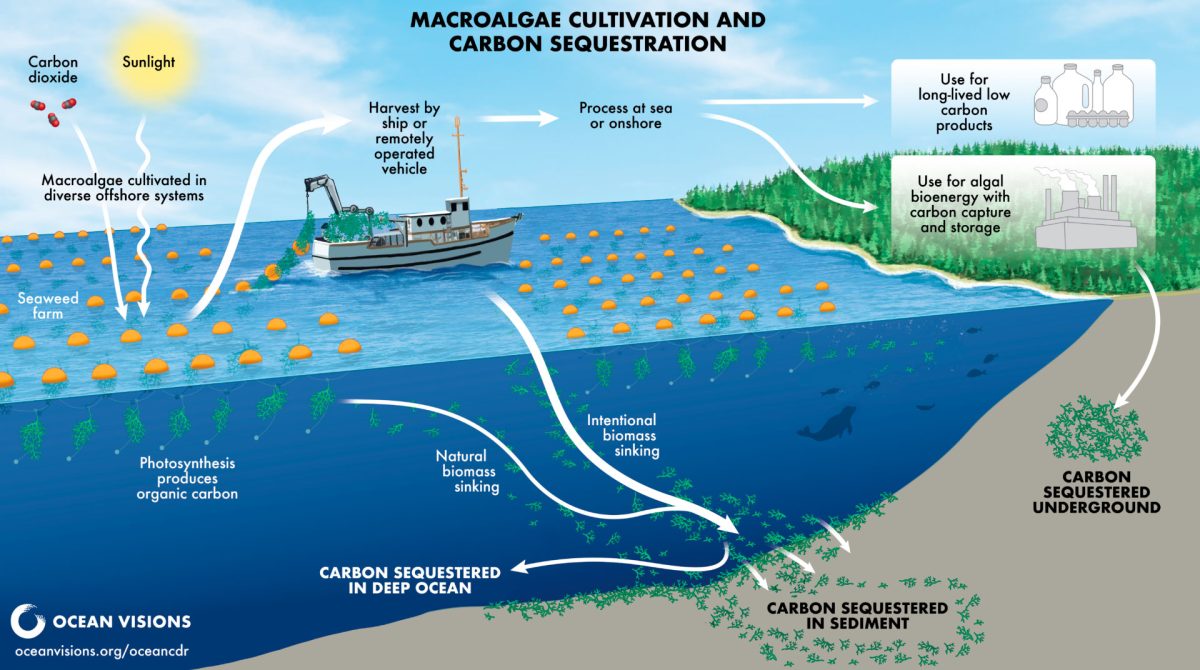
Cultivating kelp and other seaweeds can play an important role in removing carbon from the atmosphere. But scaling kelp farms up enough to make a difference is challenging. Illustration via Ocean Visions; CC-BY-NC-ND
If it works, Hooft hopes the Kelp Blue system will not only provide a product he can sell but will also take carbon from the atmosphere. “If I only wanted to make money, I would have stayed at Shell,” he said. Carbon credits are not part of his business model because he’s not getting ahead of the science in making any claims about sequestration. The farm will naturally bury some kelp before it’s harvested, as little pieces decay and fall off, but Carlos M. Duarte of the King Abdullah University of Science and Technology in Saudi Arabia and his collaborators wrote in 2017 that “the fraction of [seaweed farming’s] net primary production available to be sequestered is likely smaller than that of wild seaweed stands.” Still, they wrote, sequestration from a kelp farm could equal as much as 10 percent of the emissions avoided by a typical offshore wind farm, per square kilometer of each.
The kelp species the company is growing, Macrocystis pyrifera, forms a canopy, which is the part that’s harvested, leaving the rest for biodiversity. “We should have a regional impact on fish stocks once we’re at thousands of hectares,” Hooft said. “We’d like to get so good at planting forest that we get paid for the ecosystem services.”
Others aren’t so sure. Macrocystis isn’t native to Namibia. Dunga helped Kelp Blue research potential negative impacts on the marine and coastal ecosystem in which they are operating, but the literature of unintended consequences of introduced species is large. The Kelp Blue kelp might compete with native species for resources, crowding them out. What would that mean for phytoplankton, a critical element of the lower food web? Could Kelp Blue induce a dead zone? Or attract new species that haven’t been part of the ecosystem?

Caroline Slootweg, cofounder of Kelp Blue, examines kelp cultivated on a pilot farm in Shearwater Bay. Photo by Adriane Ohanesian
A science-based approach to kelp restoration could help avert unintended results. One of the factors that has kept restoration projects few and small is that they have involved diving, which is expensive. A novel method, developed at the Norwegian Institute for Marine Research in 2020, gets around the need for most diving by seeding the kelp onto small rocks, which can then simply be dumped overboard—no training, certification, or oxygen tank required. The method’s called green gravel.
About 20 projects on four continents have tried the method or will try it soon. One project that has taken green gravel from lab to ocean is SeaForester in Portugal. It was started by the founder of a seaweed-farming enterprise in Norway who was impressed with improvements to the local environment that he witnessed after harvesting his product. He raised some money and chose Portugal because kelp had once flourished there but had seen rapid retreat in the 21st century.
In January I went to Portugal and visited Cascais, about 45 minutes up the coast from Lisbon, to ask local fishers about their experience with the kelp and the catch. “All the sea forestation and biodiversity and quantity of animals has decreased a lot,” Antonio Olivero said. Speaking with him and his friends, I remembered that journalists’ only rival for the title of profession with the most vociferous complainers are fishers, so I decided that a chef who was hanging out with them, Louis Pereira, could be a more reliable source.
His assessment wasn’t any different. “There used to be big fishing boats coming in to Cascais with seaweeds for medicines and cosmetics,” Pereira said. “Twenty years ago, it just ended.”
The consensus among these men and a couple of others I spoke to involved the nearby sewage treatment plant. “The plant lacks the capacity to deal with the increase due to the rise in population around here,” Olivero said, “and that’s the biggest reason for the decrease in biodiversity. We don’t have enough fishers here to cause overfishing.” He showed me a video of what he said was the water a few kilometers offshore; it showed an oily film on the surface.
Francisco Teixeira, a director with the department of communication and environmental citizenship at the Portuguese Environment Agency, explained to me in an email that the area off Cascais had been deemed “less sensitive” and so, in 2001, the plant was allowed to provide “less rigorous wastewater treatment.” Nevertheless, Teixeira wrote, the area offshore is rated as having “good chemical status and good ecological status, with no indication of water quality degradation in this area.”
Later that day I met with Ana Margarida Ferreira of Cascais’s municipal sea strategy unit. We were in view of a nearshore break where some local surfers were catching some pretty epic waves, so my conversation with her is not what is foremost in my memory. But according to my notes, she told me that because the storm water drainage system is of an old design, it combines with sewage mains going to the plant. After a storm, the plant can’t handle the extra flow and an overflow is triggered, releasing some of the mixture into the sea. “It happens every winter when there’s a big rain,” she said. Still, Ferreira’s hunch is that a rise in sea temperature is more likely the cause of the kelp retreat. Water quality is improving overall, and it’s not the fishers creating the problem; they use traps and lines, not trawling nets.
Ferreira is also involved with SeaForester, and she pointed out an area beyond the surf break that was the site where the organization tried kelp restoration using a different technique. It wasn’t very successful, and the method isn’t at all scalable.
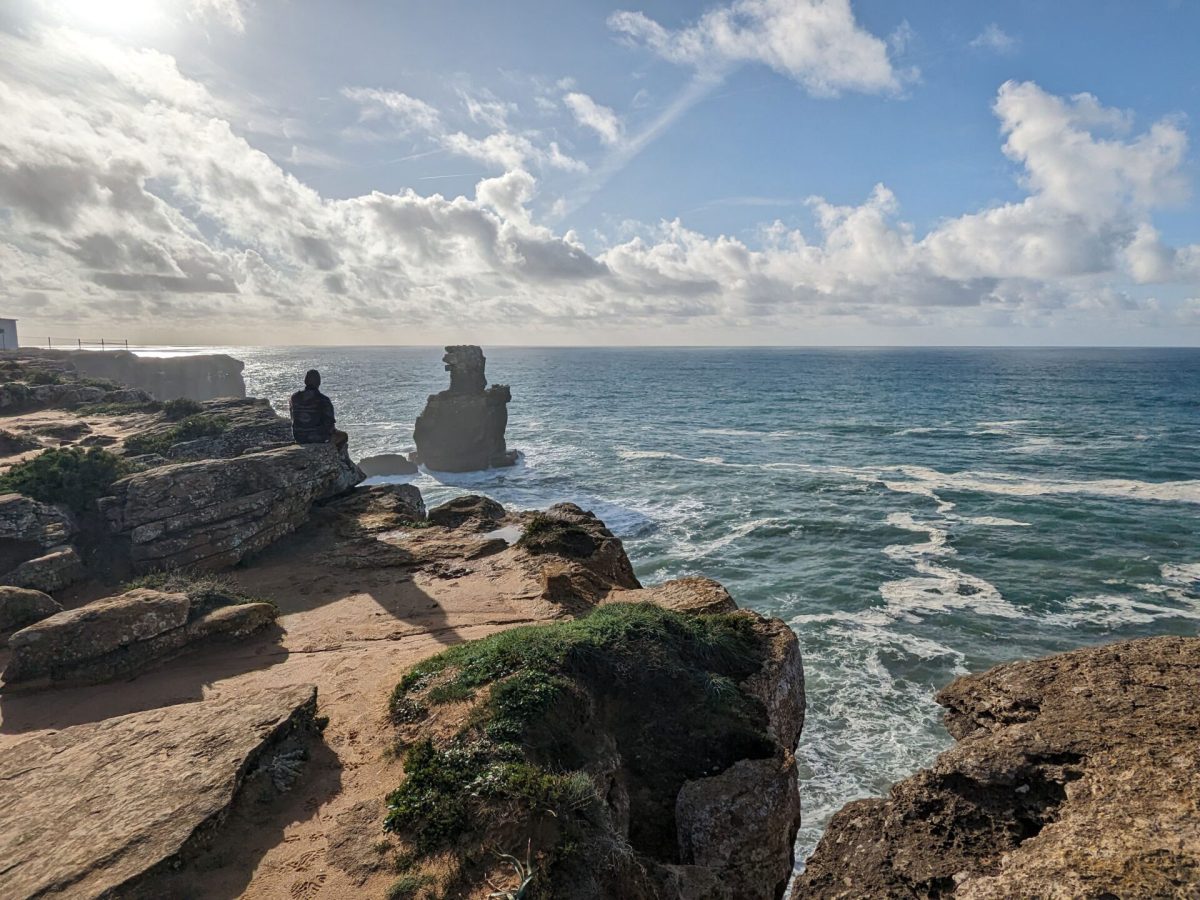
SeaForester will soon deploy the green gravel technique for kelp restoration off the coast of Peniche, Portugal. Photo by Paul Tullis
That evening, I drove another couple of hours up the coast, to Peniche (I was too late to stop along the way at Nazare, where 15-meter waves are not unheard of in January), to ask SeaForester’s scientific manager, Jan Verbeek, if he thought green gravel would have better results. I found him the next morning with a saw in his hand, standing beside a shipping container parked behind the local branch of Marine and Environmental Sciences Centre (MARE), a research, development, and innovation center that is a joint enterprise of eight Portuguese universities. Around him were scattered polyvinyl pipes, valves, rubber hoses, toolboxes, needle-nose pliers, and a tile saw. He and some colleagues from the center were in the final stages of refashioning the container into a mobile kelp nursery.
“The idea is that restoration is needed in a lot of places where there are no institutes or aquatic facilities that we could use for a nursery,” Verbeek explained. “So we thought we need some infrastructure, but don’t want to build an entire factory every time.” The containers allow SeaForester to park a nursery wherever restoration is needed for as long as it’s needed; future models will include a system to sense water temperature, salinity, and pH levels, so the whole system can be operated and monitored remotely, instead of needing to sample the water all the time.
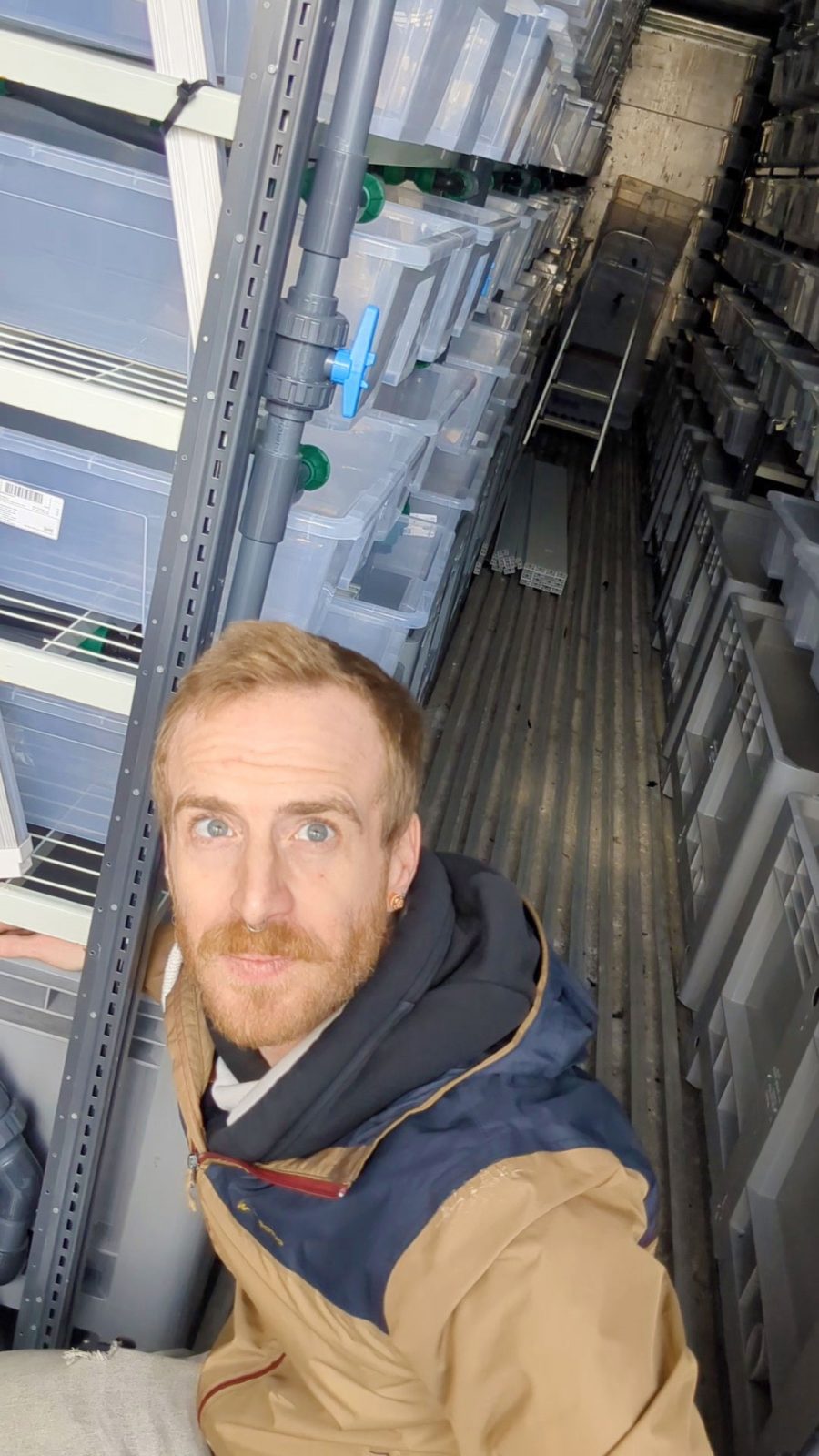
SeaForester’s scientific manager, Jan Verbeek, in the mobile kelp nursery he is helping to build in Peniche. Photo by Paul Tullis
Inside the container, 196 plastic trays of the type one might use for underbed storage rest on shelves lining either side of the container. Water pumped from larger storage containers flows through a network of pipes into the trays—where the baby kelp will grow on the gravel—then out of the trays again and down past ultraviolet and mechanical filters and into the storage container again, so the system is kept clean and constantly circulating. “Contamination is a common problem across green gravel projects and hard to get rid of,” Verbeek said. “So we try to avoid it from the outset.”
Racks inside the trays hold the rocks, so when they’re ready to deploy, the racks can be lifted out, covered with a damp towel, and placed in a pickup truck, avoiding the need to disconnect all the pipes from the trays and offload those. Lines of LED lights connected to a timer provide the kelp with the energy it needs for photosynthesis. The shelves, racks, and pipe network all had to be built to fit. “Sometimes you don’t feel like a marine biologist anymore, but a construction worker,” Verbeek said over the din of the tile saw, as a colleague constructed yet another interior rack for the trays. “Though I’m definitely developing skills I didn’t have before.”

Trays of water at the Marine and Environmental Sciences Centre (MARE) lab in Peniche contain gravel on which kelp spores develop before they are dropped into the ocean. Photo courtesy of Jan Verbeek
Inside the MARE building, marine ecologist João Nuno Franco oversees two labs, one where kelp is grown on the rocks—later to be relocated to the storage container—the other where he conducts experiments to optimize cultivation conditions to improve kelp growth.
Kelps reproduce by dropping spores following some sort of trigger in their environment, such as a change in light or temperature. These can sit on the seafloor for ages if conditions for reproduction aren’t right (at least six years, as far as anyone knows), but at some point they develop into male and female gametophytes—the sexual phase in kelp’s life cycle—which find each other, probably by sensing pheromones. In Franco’s lab, spores harvested from the wild rest in a refrigerator under red lights, so as not to be triggered to develop until he’s ready. He had seeded a batch just before Christmas, and although they were too small to see with the naked eye, Franco assured me that baby kelps were growing on the gravel and would be visible in a few weeks. Once they have grown to a couple of centimeters tall, they will be deployed at sites offshore from Peniche and Cascais. Getting the necessary permits was an issue—turns out there is no such process for nature restoration in Portugal.
After the other technique didn’t turn out so well in 2021, SeaForester tried green gravel at the same location in 2023 and saw good results. They’re hoping to improve on the method with this year’s deployment and achieve a restored canopy. Anyway, the only thing to do is to keep trying. The Green Gravel Action Group shares best practices across the different projects, so that repeated iteration might bring success. In February, SeaForester announced a sponsorship from Torq Surfboards.
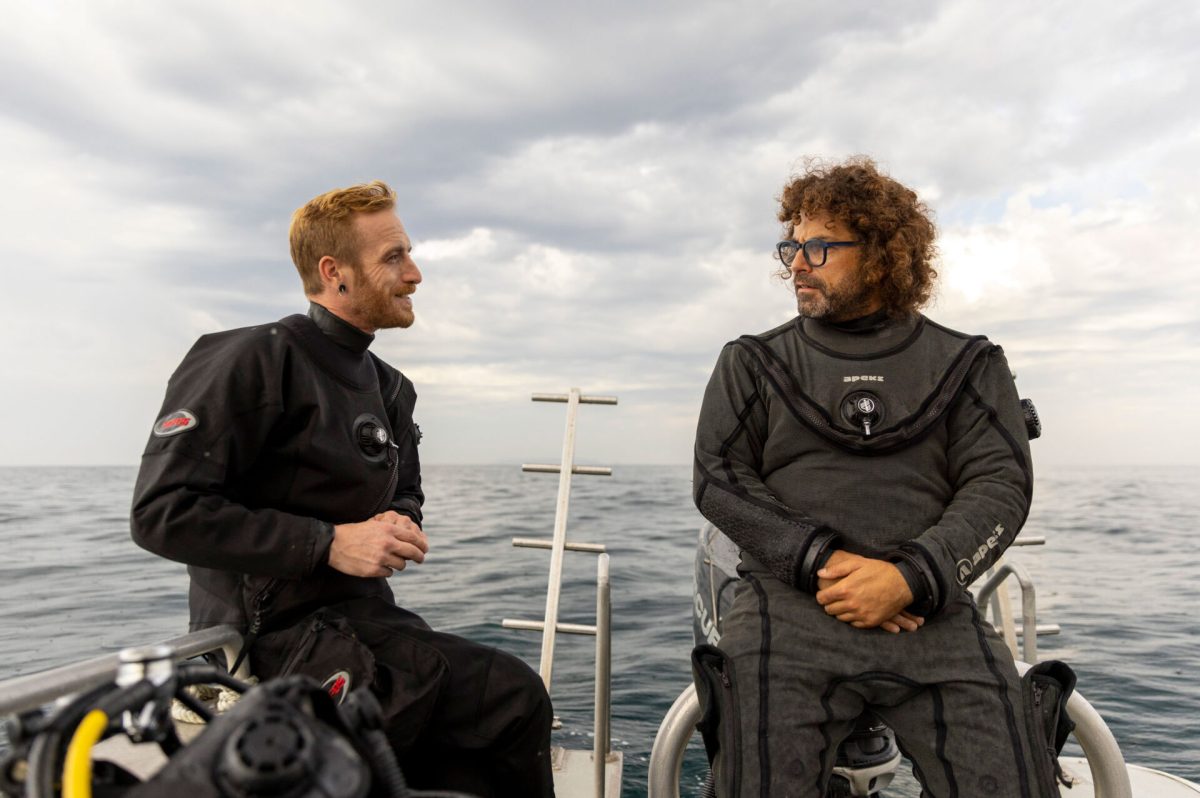
Verbeek, left, discusses diving logistics with João Nuno Franco, marine ecologist at MARE. Photo courtesy of Jan Verbeek
Reddy isn’t any closer to understanding which existing kelp forests are more at risk for decline than Verbeek and Franco are to knowing why the Cascais kelp restoration effort was unsuccessful. But her lab is leveraging a variety of tools, including mass spectrometry, to determine whether a sea forest is stressed. “If we get a good understanding of the metabolites in nature [that is, the substances that living things produce through everyday biological processes] and how they respond to climate change, we can have an early warning system,” she says. Even though the kelp there seems to be expanding, False Bay is endangered, according to Dunga’s assessment, and that worries him deeply. “If we understand why our kelp forest is expanding—when in California and Australia they’re seeing decimation of vast areas of kelp—hopefully we can prevent something like that happening in South Africa as well.”
As an undergraduate studying hydrogeology, Dunga was exposed to images of kelp forests collected by underwater vehicles; he asked his supervisors if he could accompany them the next time they went into the bay.
“I don’t know what I expected, but it blew my mind,” he says. “It was beyond what I could imagine—a fully functioning forest under the sea.” A grandfather who was a traditional healer and uses marine species to treat ailments supported his change of academic focus. Now, Dunga says, “I go around like a crazy person sharing my interest in kelp forests. Because how do you protect something that is not known? It’s human nature to protect the things we love, and we only love things that we understand.”

